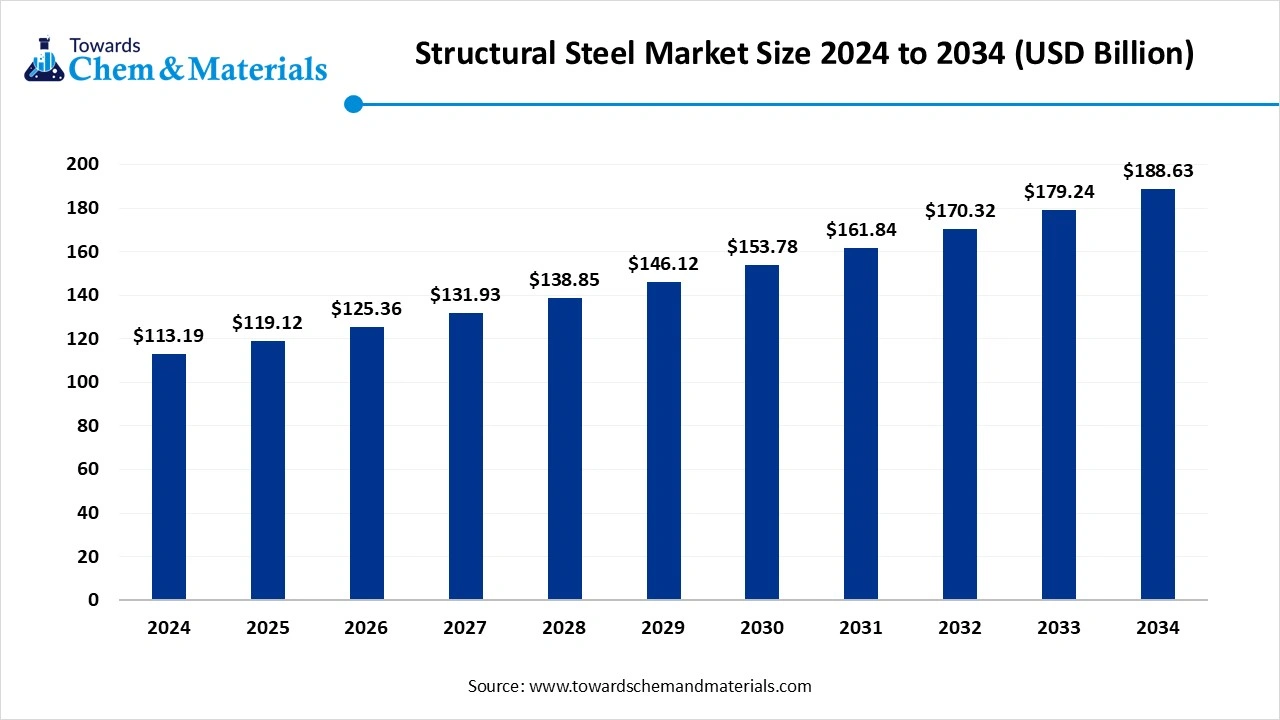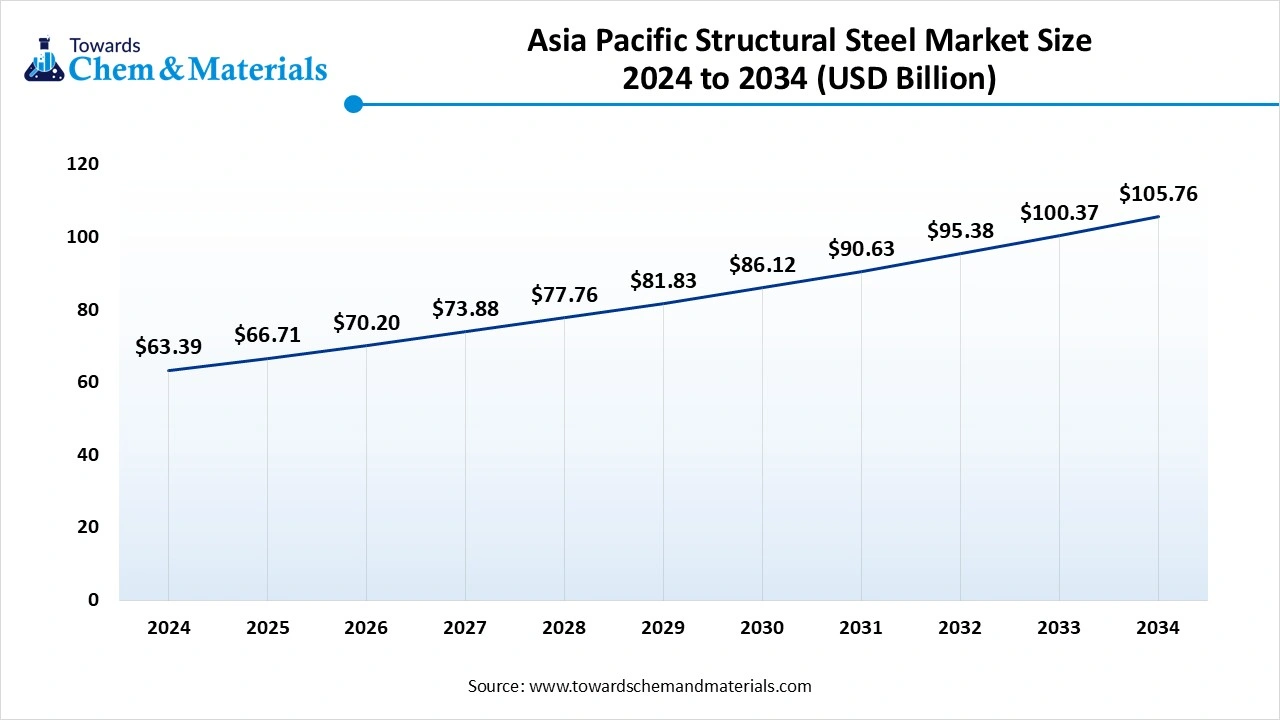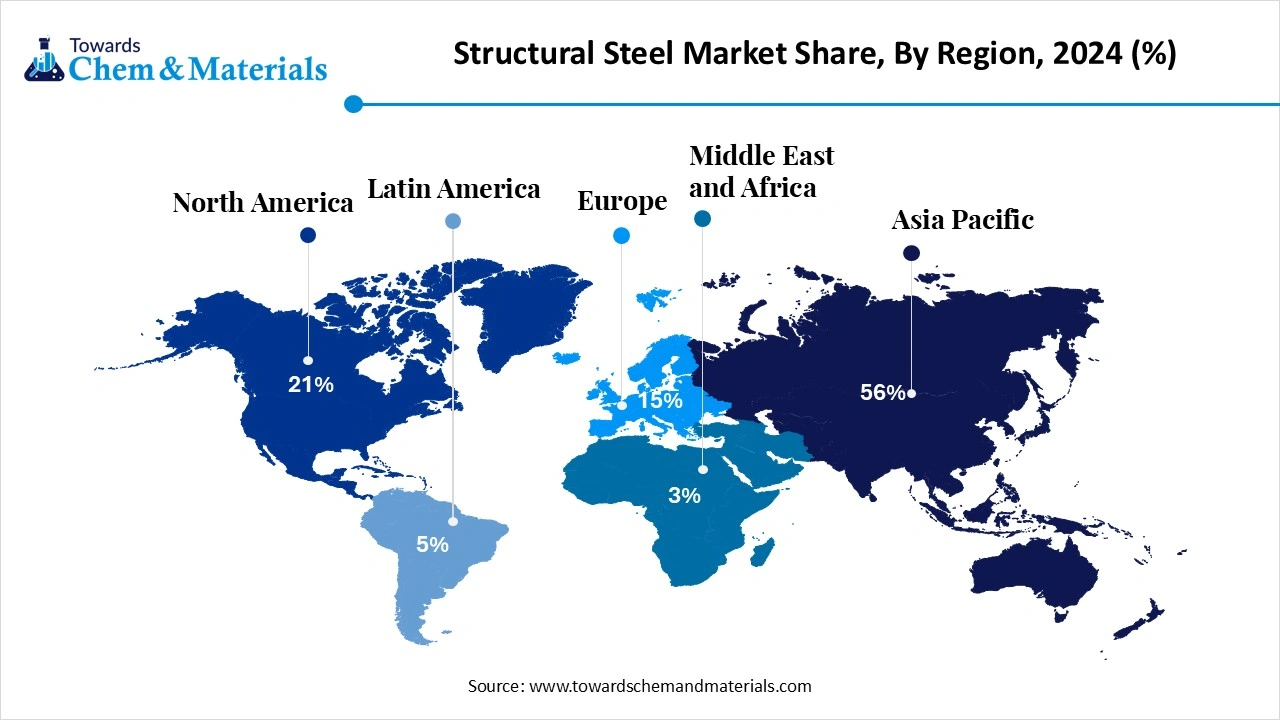November 2025
The global structural steel market size was approximately USD 119.12 billion in 2025 and is projected to reach around USD 188.63 billion by 2034, with an estimated compound annual growth rate (CAGR) of about 5.24% between 2025 and 2034. The growing demand for sustainable construction practices globally is the key factor driving market growth. Also, rapid industrialization and urbanization, coupled with the ongoing innovations in steel technology, can fuel market growth further.

The robust government spending on public projects is the major factor propelling the market growth. The global structural steel market involves the production, fabrication, and distribution of steel products specifically designed for structural applications in construction, infrastructure, and industrial projects.
Structural steel is known for its high strength-to-weight ratio, durability, and versatility, making it suitable for buildings, bridges, industrial facilities, and offshore structures. Market growth is driven by urbanization, industrialization, government infrastructure projects, and the adoption of advanced fabrication techniques such as modular construction and automated welding.
| Report Attributes | Details |
| Market Size in 2026 | USD 125.36 Billion |
| Expected Size by 2034 | USD 188.63 Billion |
| Growth Rate from 2025 to 2034 | CAGR 5.24% |
| Base Year of Estimation | 2024 |
| Forecast Period | 2025 - 2034 |
| Dominant Region | Asia Pacific |
| Segment Covered | By Product Type, By Material Type, By End-Use Industry, By Form / Shape, By Region |
| Key Companies Profiled | POSCO, Jindal Steel & Power Limited, Baosteel Group, Thyssenkrupp AG, Nucor Corporation, Severstal, Tata Steel Limited, Steel Authority of India Limited (SAIL), Hyundai Steel, Outokumpu, Essar Steel, JSW Steel , Acerinox |
Key technological shifts in the market include the adoption of digital tools such as BIM and Artificial Intelligence, along with the growing use of robotics and automation in manufacturing and fabrication. The rapid development of lightweight, high-strength, and high-performance steel alloys is expanding to fulfil demands for energy-efficient vehicles and buildings.
| Country/Region | Key Regulations |
| United States | American Society for Testing and Materials (ASTM): Establishes standard specifications for materials, including common structural steel grades like A36 and A992. |
| Canada | The Canadian Standards Association (CSA) provides comprehensive guidelines under CSA S16 for structural steel, with standards that account for the country's harsh weather, including heavy snow and ice loads. |
| Europe | Eurocodes (EN 1993): The European Committee for Standardization (CEN) developed this series of standards to harmonize structural design practices across member countries. |
Which Product Type Segment Dominated the Global Structural Steel Market in 2024?
The beams segment dominated the market with approximately 50% share in 2024. The dominance of the segment can be attributed to the growing demand for durable and high-strength building materials, along with the technological advancements in steel production. Additionally, beams are a crucial component of heavy structural steel construction projects with applications in building and bridges.
The channels segment is expected to grow at the fastest CAGR of approximately 18% over the forecast period. The growth of the segment can be credited to the rapid infrastructure development and urbanisation, coupled with the growing demand for high-performance materials in complex architectural designs. Also, structural steel is more preferred in green building construction because of its environmental benefits and recyclability.
How Much Share Did the Carbon Steel Segment Held in 2024?
The carbon steel segment held approximately 55% market share in 2024. The dominance of the segment can be linked to the growing need for cost-effective and durable materials and the rise in construction spending. Moreover, carbon steel offers a cost-effective solution and can be converted into different shapes, giving engineers and architects design freedom.
The high-strength low-alloy (HSLA) steel segment is expected to grow at the fastest CAGR over the forecast period. The growth of the segment can be driven by ongoing investment in infrastructure such as energy facilities and roads, bridges, which fuels the demand for high-strength structural steel. Furthermore, HSLA's superior strength-to-weight ratio, corrosion resistance, and toughness make it a key choice for modern construction.
Which End-Use Type Segment Dominated the Global Structural Steel Market in 2024?
The construction & infrastructure segment dominated the market with approximately 48% share in 2024. The dominance of the segment is owed to the ongoing government investments in infrastructure projects, coupled with the increasing emphasis on sustainable building practices. Also, governments across the globe are investing heavily in infrastructure projects like transportation networks, leading to further growth.
The industrial / manufacturing facilities segment is expected to grow at the fastest CAGR of approximately 20% during the projected period. The growth of the segment is due to the growing investment in infrastructure projects such as oil and gas and energy, along with the government initiatives to develop smart cities and industrial hubs. In addition, the expansion of the manufacturing industry also fuels demand for different steel products.
How Much Share Did the Hot Rolled Sections Segment Held in 2024?
The hot rolled sections segment dominated the market with approximately 52% share in 2024. The dominance of the segment can be attributed to the surge in infrastructure and construction projects in emerging regions such as the Asia Pacific. Furthermore, the high availability of hot-rolled steel and its superior properties, such as durability and strength to withstand harsh conditions, make it a preferred choice among market players.
The fabricated / prefabricated steel sections segment is expected to grow at the fastest CAGR of approximately 20% during the study period. The growth of the segment can be credited to the increasing need for cost-effective and sustainable construction solutions, coupled with the technological innovations in prefabrication and building information modelling (BIM). Prefabricated steel gives a more efficient and sustainable construction method.
The Asia Pacific structural steel market size is valued at USD 66.71 billion in 2025 and is expected to reach USD 105.76 billion by 2034, growing at a CAGR of 5.26% from 2025 to 2034. Asia Pacific dominated the market with approximately 56% share in 2024.

The dominance of the region can be attributed to the expanding commercial and residential construction sector, along with the growing demand for high-strength steel in skyscraper construction. In addition, the growth of the aerospace, automotive, and other heavy industries needs large amounts of structural steel, driving regional growth further.
China Global Structural Steel Market Trends
In the Asia Pacific, China led the market due to the innovations in steel production and technology. China's emphasis on large-scale infrastructure projects, like bridges, airports, and high-speed rail, is a major factor in the market's exponential growth in the country.
North America is expected to grow at the fastest CAGR over the forecast period.
The growth of the region can be credited to the ongoing government investment in infrastructure projects, along with the push towards sustainable construction methods. Furthermore, stringent building regulations in the country mandate the use of high-grade durable materials, which fuels the demand for structural steel.
U.S. Global Structural Steel Market Trends
In North America, the U.S. dominated the market due to the growing adoption of prefabricated and sustainable construction methods. Also, advancements in steel fabrication and the development of high-strength steel alloys are making the construction more efficient, faster, and more cost-effective in the country.
Europe is expected to grow at a notable CAGR over the projected period.
The growth of the region can be driven by increasing emphasis on sustainability and green steel initiatives, coupled with the growing product demand from key sectors such as non-residential construction and automotive. European nations are heavily investing in sustainable manufacturing methods to enhance overall energy efficiency.

Germany Global Structural Steel Market Trends
In Europe, Germany shows significant growth, boosted by a strong export market in the country and international collaborations to ensure an ongoing supply of high-quality steel. Moreover, stringent policies such as Germany's Climate Action Plan are pushing towards lower carbon emissions and propelling the adoption of green steel production.
By Product Type
By Material Type
By End-Use Industry
By Form / Shape
By Region
November 2025
November 2025
November 2025
November 2025